FFGC240: Analysis of Fire Service Response to Aviation Incidents
VerifiedAdded on 2023/06/10
|15
|5943
|383
Report
AI Summary
This report provides a comprehensive analysis of fire service responses to transport incidents, specifically focusing on aviation and maritime scenarios. The aviation section delves into relevant legislation like the Fire and Rescue Service Act and Disaster Management Act, outlining the roles of various agencies such as Air Traffic Control, Queensland Police Service, and the Airport Operator during aviation incidents. It examines aircraft features, including construction materials and aviation fuels, highlighting potential hazards for firefighters like magnesium alloys, depleted uranium, and specific fuel types. The report also presents a case study of an airport incident, detailing the response process, priorities, and challenges faced, including fire escalation, evacuation procedures, and communication effectiveness. The maritime section briefly touches upon vessel types and their implications for fire response. The report emphasizes the importance of understanding hazards, coordinating responses, and applying appropriate firefighting techniques to ensure safety and minimize damage in both aviation and maritime emergencies.
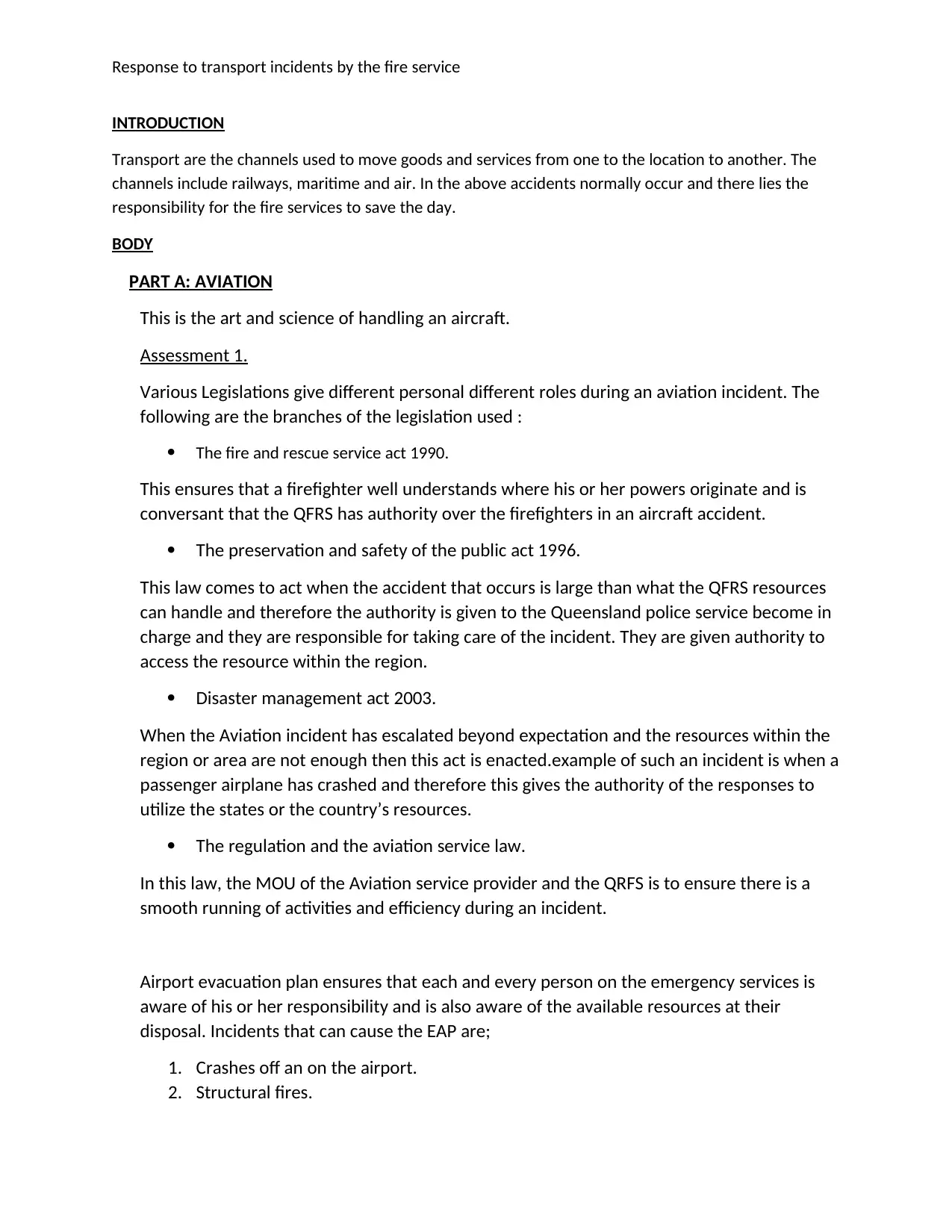
Response to transport incidents by the fire service
INTRODUCTION
Transport are the channels used to move goods and services from one to the location to another. The
channels include railways, maritime and air. In the above accidents normally occur and there lies the
responsibility for the fire services to save the day.
BODY
PART A: AVIATION
This is the art and science of handling an aircraft.
Assessment 1.
Various Legislations give different personal different roles during an aviation incident. The
following are the branches of the legislation used :
The fire and rescue service act 1990.
This ensures that a firefighter well understands where his or her powers originate and is
conversant that the QFRS has authority over the firefighters in an aircraft accident.
The preservation and safety of the public act 1996.
This law comes to act when the accident that occurs is large than what the QFRS resources
can handle and therefore the authority is given to the Queensland police service become in
charge and they are responsible for taking care of the incident. They are given authority to
access the resource within the region.
Disaster management act 2003.
When the Aviation incident has escalated beyond expectation and the resources within the
region or area are not enough then this act is enacted.example of such an incident is when a
passenger airplane has crashed and therefore this gives the authority of the responses to
utilize the states or the country’s resources.
The regulation and the aviation service law.
In this law, the MOU of the Aviation service provider and the QRFS is to ensure there is a
smooth running of activities and efficiency during an incident.
Airport evacuation plan ensures that each and every person on the emergency services is
aware of his or her responsibility and is also aware of the available resources at their
disposal. Incidents that can cause the EAP are;
1. Crashes off an on the airport.
2. Structural fires.
INTRODUCTION
Transport are the channels used to move goods and services from one to the location to another. The
channels include railways, maritime and air. In the above accidents normally occur and there lies the
responsibility for the fire services to save the day.
BODY
PART A: AVIATION
This is the art and science of handling an aircraft.
Assessment 1.
Various Legislations give different personal different roles during an aviation incident. The
following are the branches of the legislation used :
The fire and rescue service act 1990.
This ensures that a firefighter well understands where his or her powers originate and is
conversant that the QFRS has authority over the firefighters in an aircraft accident.
The preservation and safety of the public act 1996.
This law comes to act when the accident that occurs is large than what the QFRS resources
can handle and therefore the authority is given to the Queensland police service become in
charge and they are responsible for taking care of the incident. They are given authority to
access the resource within the region.
Disaster management act 2003.
When the Aviation incident has escalated beyond expectation and the resources within the
region or area are not enough then this act is enacted.example of such an incident is when a
passenger airplane has crashed and therefore this gives the authority of the responses to
utilize the states or the country’s resources.
The regulation and the aviation service law.
In this law, the MOU of the Aviation service provider and the QRFS is to ensure there is a
smooth running of activities and efficiency during an incident.
Airport evacuation plan ensures that each and every person on the emergency services is
aware of his or her responsibility and is also aware of the available resources at their
disposal. Incidents that can cause the EAP are;
1. Crashes off an on the airport.
2. Structural fires.
Paraphrase This Document
Need a fresh take? Get an instant paraphrase of this document with our AI Paraphraser
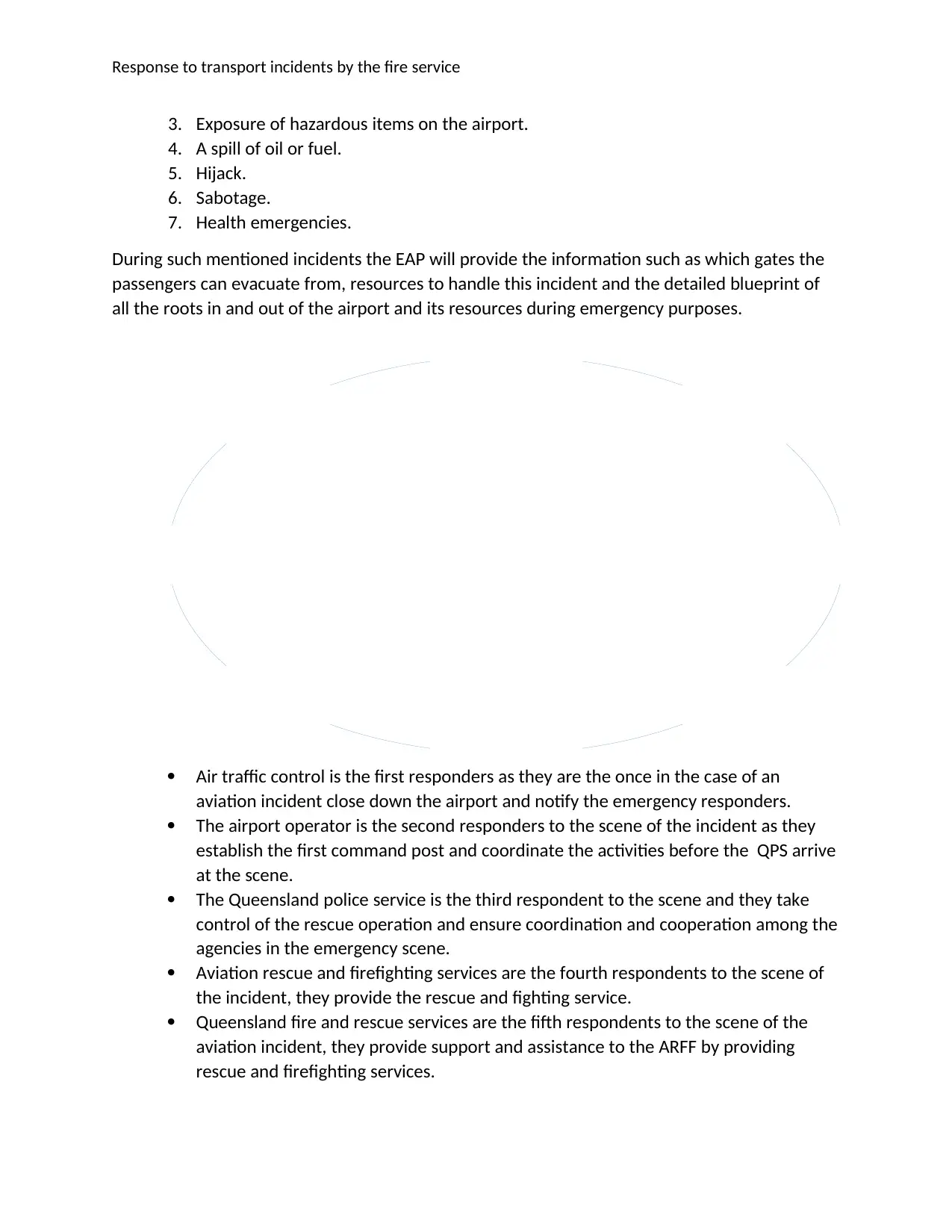
Response to transport incidents by the fire service
3. Exposure of hazardous items on the airport.
4. A spill of oil or fuel.
5. Hijack.
6. Sabotage.
7. Health emergencies.
During such mentioned incidents the EAP will provide the information such as which gates the
passengers can evacuate from, resources to handle this incident and the detailed blueprint of
all the roots in and out of the airport and its resources during emergency purposes.
Air traffic control is the first responders as they are the once in the case of an
aviation incident close down the airport and notify the emergency responders.
The airport operator is the second responders to the scene of the incident as they
establish the first command post and coordinate the activities before the QPS arrive
at the scene.
The Queensland police service is the third respondent to the scene and they take
control of the rescue operation and ensure coordination and cooperation among the
agencies in the emergency scene.
Aviation rescue and firefighting services are the fourth respondents to the scene of
the incident, they provide the rescue and fighting service.
Queensland fire and rescue services are the fifth respondents to the scene of the
aviation incident, they provide support and assistance to the ARFF by providing
rescue and firefighting services.
AIRTRAFFICCONTROLAIRPORTOPERATORTHEQUEENSLANDPOLICESERVICEAVIATIONRESCUEANDFIREFIGHTINGSERVICESQUEENSLANDFIREANDRESCUESERVICESAIRLINEOPERATORQUEENSLANDAMBULANCESERVICESHOSPITALS
3. Exposure of hazardous items on the airport.
4. A spill of oil or fuel.
5. Hijack.
6. Sabotage.
7. Health emergencies.
During such mentioned incidents the EAP will provide the information such as which gates the
passengers can evacuate from, resources to handle this incident and the detailed blueprint of
all the roots in and out of the airport and its resources during emergency purposes.
Air traffic control is the first responders as they are the once in the case of an
aviation incident close down the airport and notify the emergency responders.
The airport operator is the second responders to the scene of the incident as they
establish the first command post and coordinate the activities before the QPS arrive
at the scene.
The Queensland police service is the third respondent to the scene and they take
control of the rescue operation and ensure coordination and cooperation among the
agencies in the emergency scene.
Aviation rescue and firefighting services are the fourth respondents to the scene of
the incident, they provide the rescue and fighting service.
Queensland fire and rescue services are the fifth respondents to the scene of the
aviation incident, they provide support and assistance to the ARFF by providing
rescue and firefighting services.
AIRTRAFFICCONTROLAIRPORTOPERATORTHEQUEENSLANDPOLICESERVICEAVIATIONRESCUEANDFIREFIGHTINGSERVICESQUEENSLANDFIREANDRESCUESERVICESAIRLINEOPERATORQUEENSLANDAMBULANCESERVICESHOSPITALS
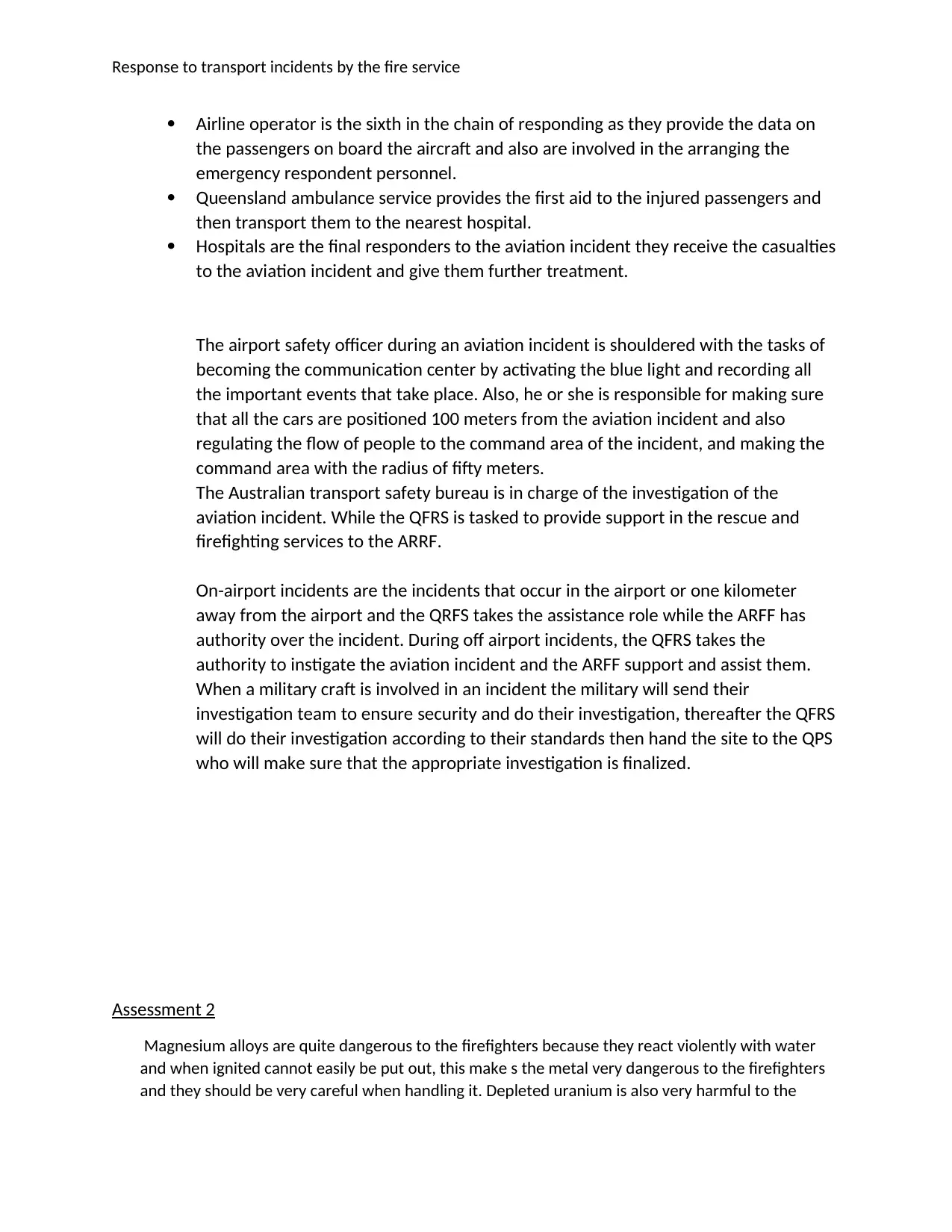
Response to transport incidents by the fire service
Airline operator is the sixth in the chain of responding as they provide the data on
the passengers on board the aircraft and also are involved in the arranging the
emergency respondent personnel.
Queensland ambulance service provides the first aid to the injured passengers and
then transport them to the nearest hospital.
Hospitals are the final responders to the aviation incident they receive the casualties
to the aviation incident and give them further treatment.
The airport safety officer during an aviation incident is shouldered with the tasks of
becoming the communication center by activating the blue light and recording all
the important events that take place. Also, he or she is responsible for making sure
that all the cars are positioned 100 meters from the aviation incident and also
regulating the flow of people to the command area of the incident, and making the
command area with the radius of fifty meters.
The Australian transport safety bureau is in charge of the investigation of the
aviation incident. While the QFRS is tasked to provide support in the rescue and
firefighting services to the ARRF.
On-airport incidents are the incidents that occur in the airport or one kilometer
away from the airport and the QRFS takes the assistance role while the ARFF has
authority over the incident. During off airport incidents, the QFRS takes the
authority to instigate the aviation incident and the ARFF support and assist them.
When a military craft is involved in an incident the military will send their
investigation team to ensure security and do their investigation, thereafter the QFRS
will do their investigation according to their standards then hand the site to the QPS
who will make sure that the appropriate investigation is finalized.
Assessment 2
Magnesium alloys are quite dangerous to the firefighters because they react violently with water
and when ignited cannot easily be put out, this make s the metal very dangerous to the firefighters
and they should be very careful when handling it. Depleted uranium is also very harmful to the
Airline operator is the sixth in the chain of responding as they provide the data on
the passengers on board the aircraft and also are involved in the arranging the
emergency respondent personnel.
Queensland ambulance service provides the first aid to the injured passengers and
then transport them to the nearest hospital.
Hospitals are the final responders to the aviation incident they receive the casualties
to the aviation incident and give them further treatment.
The airport safety officer during an aviation incident is shouldered with the tasks of
becoming the communication center by activating the blue light and recording all
the important events that take place. Also, he or she is responsible for making sure
that all the cars are positioned 100 meters from the aviation incident and also
regulating the flow of people to the command area of the incident, and making the
command area with the radius of fifty meters.
The Australian transport safety bureau is in charge of the investigation of the
aviation incident. While the QFRS is tasked to provide support in the rescue and
firefighting services to the ARRF.
On-airport incidents are the incidents that occur in the airport or one kilometer
away from the airport and the QRFS takes the assistance role while the ARFF has
authority over the incident. During off airport incidents, the QFRS takes the
authority to instigate the aviation incident and the ARFF support and assist them.
When a military craft is involved in an incident the military will send their
investigation team to ensure security and do their investigation, thereafter the QFRS
will do their investigation according to their standards then hand the site to the QPS
who will make sure that the appropriate investigation is finalized.
Assessment 2
Magnesium alloys are quite dangerous to the firefighters because they react violently with water
and when ignited cannot easily be put out, this make s the metal very dangerous to the firefighters
and they should be very careful when handling it. Depleted uranium is also very harmful to the
⊘ This is a preview!⊘
Do you want full access?
Subscribe today to unlock all pages.

Trusted by 1+ million students worldwide
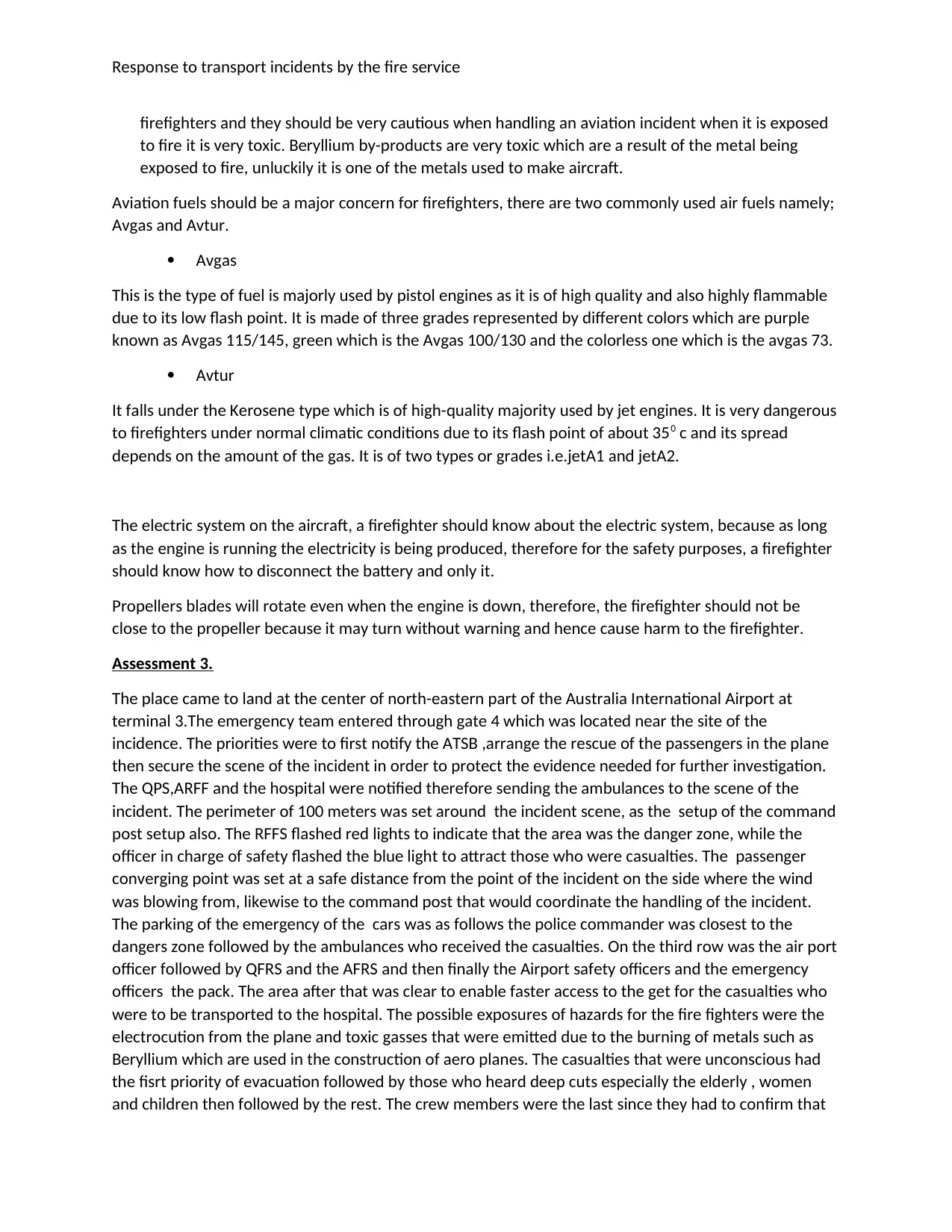
Response to transport incidents by the fire service
firefighters and they should be very cautious when handling an aviation incident when it is exposed
to fire it is very toxic. Beryllium by-products are very toxic which are a result of the metal being
exposed to fire, unluckily it is one of the metals used to make aircraft.
Aviation fuels should be a major concern for firefighters, there are two commonly used air fuels namely;
Avgas and Avtur.
Avgas
This is the type of fuel is majorly used by pistol engines as it is of high quality and also highly flammable
due to its low flash point. It is made of three grades represented by different colors which are purple
known as Avgas 115/145, green which is the Avgas 100/130 and the colorless one which is the avgas 73.
Avtur
It falls under the Kerosene type which is of high-quality majority used by jet engines. It is very dangerous
to firefighters under normal climatic conditions due to its flash point of about 350 c and its spread
depends on the amount of the gas. It is of two types or grades i.e.jetA1 and jetA2.
The electric system on the aircraft, a firefighter should know about the electric system, because as long
as the engine is running the electricity is being produced, therefore for the safety purposes, a firefighter
should know how to disconnect the battery and only it.
Propellers blades will rotate even when the engine is down, therefore, the firefighter should not be
close to the propeller because it may turn without warning and hence cause harm to the firefighter.
Assessment 3.
The place came to land at the center of north-eastern part of the Australia International Airport at
terminal 3.The emergency team entered through gate 4 which was located near the site of the
incidence. The priorities were to first notify the ATSB ,arrange the rescue of the passengers in the plane
then secure the scene of the incident in order to protect the evidence needed for further investigation.
The QPS,ARFF and the hospital were notified therefore sending the ambulances to the scene of the
incident. The perimeter of 100 meters was set around the incident scene, as the setup of the command
post setup also. The RFFS flashed red lights to indicate that the area was the danger zone, while the
officer in charge of safety flashed the blue light to attract those who were casualties. The passenger
converging point was set at a safe distance from the point of the incident on the side where the wind
was blowing from, likewise to the command post that would coordinate the handling of the incident.
The parking of the emergency of the cars was as follows the police commander was closest to the
dangers zone followed by the ambulances who received the casualties. On the third row was the air port
officer followed by QFRS and the AFRS and then finally the Airport safety officers and the emergency
officers the pack. The area after that was clear to enable faster access to the get for the casualties who
were to be transported to the hospital. The possible exposures of hazards for the fire fighters were the
electrocution from the plane and toxic gasses that were emitted due to the burning of metals such as
Beryllium which are used in the construction of aero planes. The casualties that were unconscious had
the fisrt priority of evacuation followed by those who heard deep cuts especially the elderly , women
and children then followed by the rest. The crew members were the last since they had to confirm that
firefighters and they should be very cautious when handling an aviation incident when it is exposed
to fire it is very toxic. Beryllium by-products are very toxic which are a result of the metal being
exposed to fire, unluckily it is one of the metals used to make aircraft.
Aviation fuels should be a major concern for firefighters, there are two commonly used air fuels namely;
Avgas and Avtur.
Avgas
This is the type of fuel is majorly used by pistol engines as it is of high quality and also highly flammable
due to its low flash point. It is made of three grades represented by different colors which are purple
known as Avgas 115/145, green which is the Avgas 100/130 and the colorless one which is the avgas 73.
Avtur
It falls under the Kerosene type which is of high-quality majority used by jet engines. It is very dangerous
to firefighters under normal climatic conditions due to its flash point of about 350 c and its spread
depends on the amount of the gas. It is of two types or grades i.e.jetA1 and jetA2.
The electric system on the aircraft, a firefighter should know about the electric system, because as long
as the engine is running the electricity is being produced, therefore for the safety purposes, a firefighter
should know how to disconnect the battery and only it.
Propellers blades will rotate even when the engine is down, therefore, the firefighter should not be
close to the propeller because it may turn without warning and hence cause harm to the firefighter.
Assessment 3.
The place came to land at the center of north-eastern part of the Australia International Airport at
terminal 3.The emergency team entered through gate 4 which was located near the site of the
incidence. The priorities were to first notify the ATSB ,arrange the rescue of the passengers in the plane
then secure the scene of the incident in order to protect the evidence needed for further investigation.
The QPS,ARFF and the hospital were notified therefore sending the ambulances to the scene of the
incident. The perimeter of 100 meters was set around the incident scene, as the setup of the command
post setup also. The RFFS flashed red lights to indicate that the area was the danger zone, while the
officer in charge of safety flashed the blue light to attract those who were casualties. The passenger
converging point was set at a safe distance from the point of the incident on the side where the wind
was blowing from, likewise to the command post that would coordinate the handling of the incident.
The parking of the emergency of the cars was as follows the police commander was closest to the
dangers zone followed by the ambulances who received the casualties. On the third row was the air port
officer followed by QFRS and the AFRS and then finally the Airport safety officers and the emergency
officers the pack. The area after that was clear to enable faster access to the get for the casualties who
were to be transported to the hospital. The possible exposures of hazards for the fire fighters were the
electrocution from the plane and toxic gasses that were emitted due to the burning of metals such as
Beryllium which are used in the construction of aero planes. The casualties that were unconscious had
the fisrt priority of evacuation followed by those who heard deep cuts especially the elderly , women
and children then followed by the rest. The crew members were the last since they had to confirm that
Paraphrase This Document
Need a fresh take? Get an instant paraphrase of this document with our AI Paraphraser
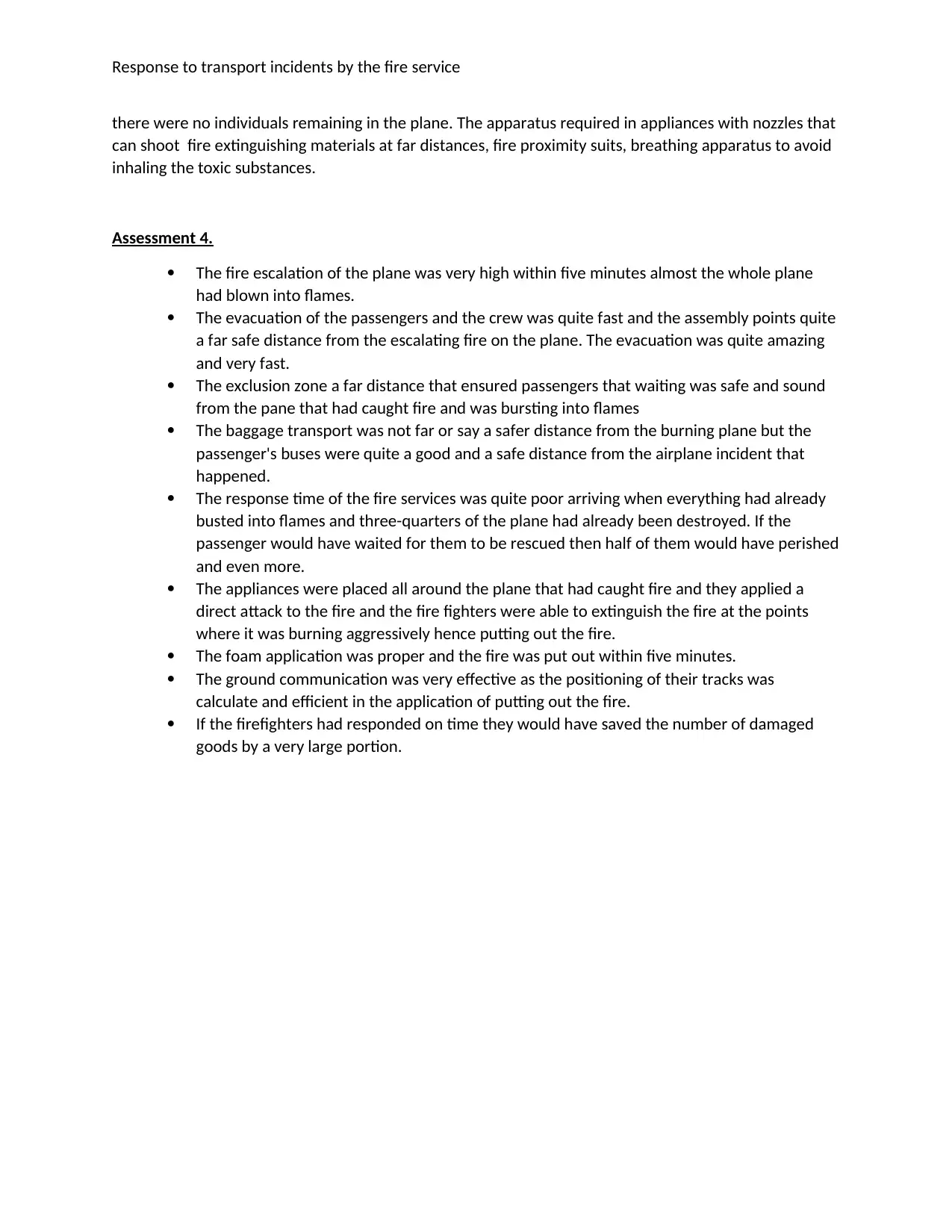
Response to transport incidents by the fire service
there were no individuals remaining in the plane. The apparatus required in appliances with nozzles that
can shoot fire extinguishing materials at far distances, fire proximity suits, breathing apparatus to avoid
inhaling the toxic substances.
Assessment 4.
The fire escalation of the plane was very high within five minutes almost the whole plane
had blown into flames.
The evacuation of the passengers and the crew was quite fast and the assembly points quite
a far safe distance from the escalating fire on the plane. The evacuation was quite amazing
and very fast.
The exclusion zone a far distance that ensured passengers that waiting was safe and sound
from the pane that had caught fire and was bursting into flames
The baggage transport was not far or say a safer distance from the burning plane but the
passenger's buses were quite a good and a safe distance from the airplane incident that
happened.
The response time of the fire services was quite poor arriving when everything had already
busted into flames and three-quarters of the plane had already been destroyed. If the
passenger would have waited for them to be rescued then half of them would have perished
and even more.
The appliances were placed all around the plane that had caught fire and they applied a
direct attack to the fire and the fire fighters were able to extinguish the fire at the points
where it was burning aggressively hence putting out the fire.
The foam application was proper and the fire was put out within five minutes.
The ground communication was very effective as the positioning of their tracks was
calculate and efficient in the application of putting out the fire.
If the firefighters had responded on time they would have saved the number of damaged
goods by a very large portion.
there were no individuals remaining in the plane. The apparatus required in appliances with nozzles that
can shoot fire extinguishing materials at far distances, fire proximity suits, breathing apparatus to avoid
inhaling the toxic substances.
Assessment 4.
The fire escalation of the plane was very high within five minutes almost the whole plane
had blown into flames.
The evacuation of the passengers and the crew was quite fast and the assembly points quite
a far safe distance from the escalating fire on the plane. The evacuation was quite amazing
and very fast.
The exclusion zone a far distance that ensured passengers that waiting was safe and sound
from the pane that had caught fire and was bursting into flames
The baggage transport was not far or say a safer distance from the burning plane but the
passenger's buses were quite a good and a safe distance from the airplane incident that
happened.
The response time of the fire services was quite poor arriving when everything had already
busted into flames and three-quarters of the plane had already been destroyed. If the
passenger would have waited for them to be rescued then half of them would have perished
and even more.
The appliances were placed all around the plane that had caught fire and they applied a
direct attack to the fire and the fire fighters were able to extinguish the fire at the points
where it was burning aggressively hence putting out the fire.
The foam application was proper and the fire was put out within five minutes.
The ground communication was very effective as the positioning of their tracks was
calculate and efficient in the application of putting out the fire.
If the firefighters had responded on time they would have saved the number of damaged
goods by a very large portion.
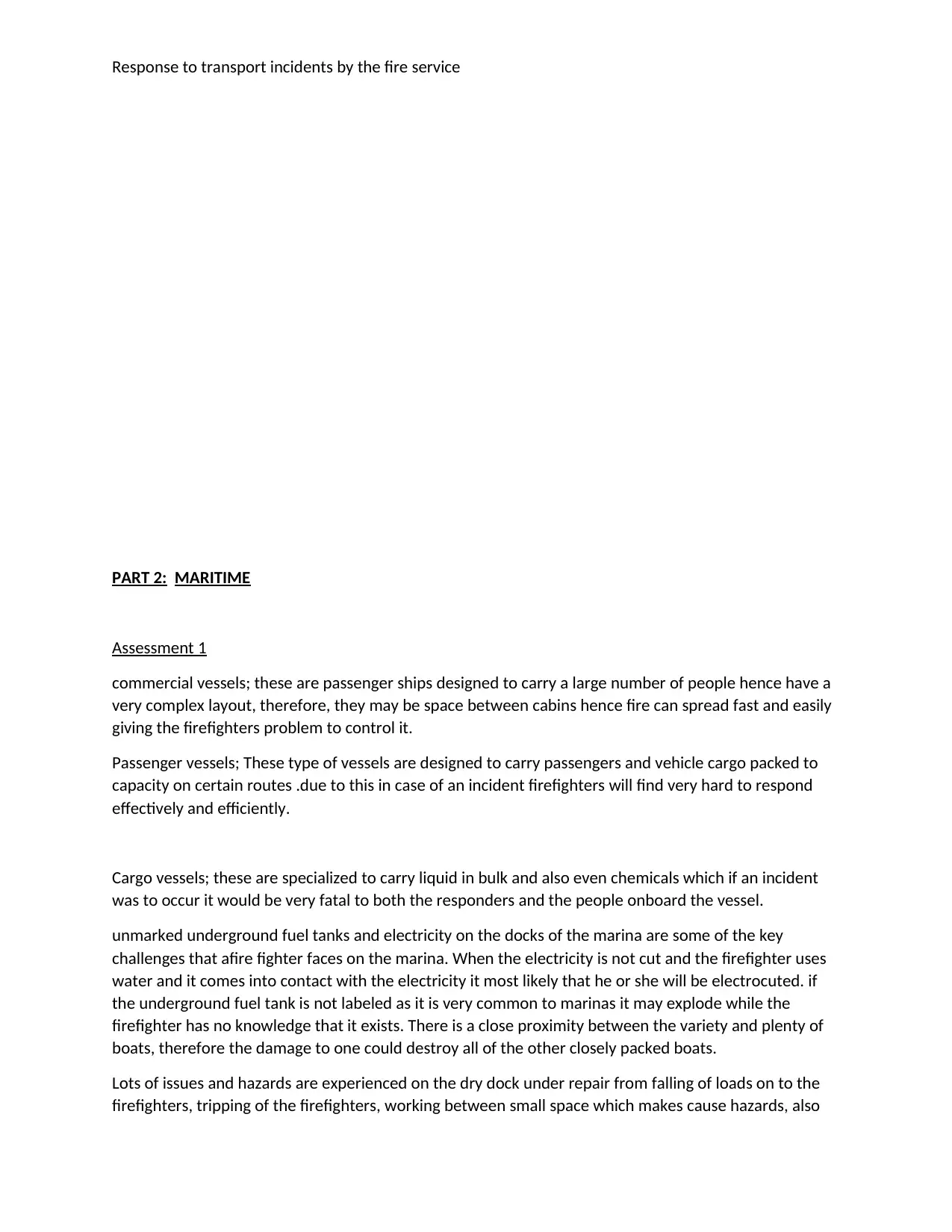
Response to transport incidents by the fire service
PART 2: MARITIME
Assessment 1
commercial vessels; these are passenger ships designed to carry a large number of people hence have a
very complex layout, therefore, they may be space between cabins hence fire can spread fast and easily
giving the firefighters problem to control it.
Passenger vessels; These type of vessels are designed to carry passengers and vehicle cargo packed to
capacity on certain routes .due to this in case of an incident firefighters will find very hard to respond
effectively and efficiently.
Cargo vessels; these are specialized to carry liquid in bulk and also even chemicals which if an incident
was to occur it would be very fatal to both the responders and the people onboard the vessel.
unmarked underground fuel tanks and electricity on the docks of the marina are some of the key
challenges that afire fighter faces on the marina. When the electricity is not cut and the firefighter uses
water and it comes into contact with the electricity it most likely that he or she will be electrocuted. if
the underground fuel tank is not labeled as it is very common to marinas it may explode while the
firefighter has no knowledge that it exists. There is a close proximity between the variety and plenty of
boats, therefore the damage to one could destroy all of the other closely packed boats.
Lots of issues and hazards are experienced on the dry dock under repair from falling of loads on to the
firefighters, tripping of the firefighters, working between small space which makes cause hazards, also
PART 2: MARITIME
Assessment 1
commercial vessels; these are passenger ships designed to carry a large number of people hence have a
very complex layout, therefore, they may be space between cabins hence fire can spread fast and easily
giving the firefighters problem to control it.
Passenger vessels; These type of vessels are designed to carry passengers and vehicle cargo packed to
capacity on certain routes .due to this in case of an incident firefighters will find very hard to respond
effectively and efficiently.
Cargo vessels; these are specialized to carry liquid in bulk and also even chemicals which if an incident
was to occur it would be very fatal to both the responders and the people onboard the vessel.
unmarked underground fuel tanks and electricity on the docks of the marina are some of the key
challenges that afire fighter faces on the marina. When the electricity is not cut and the firefighter uses
water and it comes into contact with the electricity it most likely that he or she will be electrocuted. if
the underground fuel tank is not labeled as it is very common to marinas it may explode while the
firefighter has no knowledge that it exists. There is a close proximity between the variety and plenty of
boats, therefore the damage to one could destroy all of the other closely packed boats.
Lots of issues and hazards are experienced on the dry dock under repair from falling of loads on to the
firefighters, tripping of the firefighters, working between small space which makes cause hazards, also
⊘ This is a preview!⊘
Do you want full access?
Subscribe today to unlock all pages.

Trusted by 1+ million students worldwide
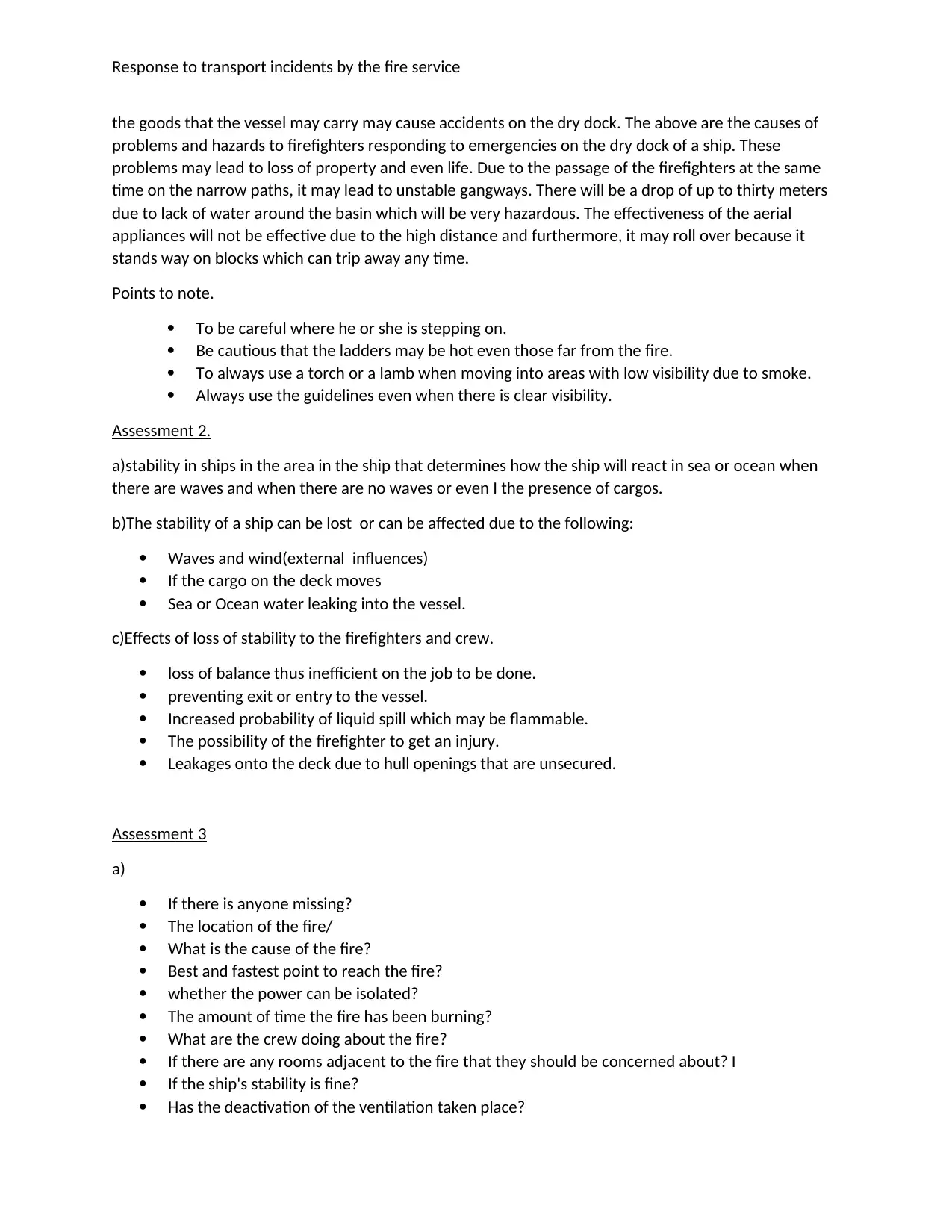
Response to transport incidents by the fire service
the goods that the vessel may carry may cause accidents on the dry dock. The above are the causes of
problems and hazards to firefighters responding to emergencies on the dry dock of a ship. These
problems may lead to loss of property and even life. Due to the passage of the firefighters at the same
time on the narrow paths, it may lead to unstable gangways. There will be a drop of up to thirty meters
due to lack of water around the basin which will be very hazardous. The effectiveness of the aerial
appliances will not be effective due to the high distance and furthermore, it may roll over because it
stands way on blocks which can trip away any time.
Points to note.
To be careful where he or she is stepping on.
Be cautious that the ladders may be hot even those far from the fire.
To always use a torch or a lamb when moving into areas with low visibility due to smoke.
Always use the guidelines even when there is clear visibility.
Assessment 2.
a)stability in ships in the area in the ship that determines how the ship will react in sea or ocean when
there are waves and when there are no waves or even I the presence of cargos.
b)The stability of a ship can be lost or can be affected due to the following:
Waves and wind(external influences)
If the cargo on the deck moves
Sea or Ocean water leaking into the vessel.
c)Effects of loss of stability to the firefighters and crew.
loss of balance thus inefficient on the job to be done.
preventing exit or entry to the vessel.
Increased probability of liquid spill which may be flammable.
The possibility of the firefighter to get an injury.
Leakages onto the deck due to hull openings that are unsecured.
Assessment 3
a)
If there is anyone missing?
The location of the fire/
What is the cause of the fire?
Best and fastest point to reach the fire?
whether the power can be isolated?
The amount of time the fire has been burning?
What are the crew doing about the fire?
If there are any rooms adjacent to the fire that they should be concerned about? I
If the ship's stability is fine?
Has the deactivation of the ventilation taken place?
the goods that the vessel may carry may cause accidents on the dry dock. The above are the causes of
problems and hazards to firefighters responding to emergencies on the dry dock of a ship. These
problems may lead to loss of property and even life. Due to the passage of the firefighters at the same
time on the narrow paths, it may lead to unstable gangways. There will be a drop of up to thirty meters
due to lack of water around the basin which will be very hazardous. The effectiveness of the aerial
appliances will not be effective due to the high distance and furthermore, it may roll over because it
stands way on blocks which can trip away any time.
Points to note.
To be careful where he or she is stepping on.
Be cautious that the ladders may be hot even those far from the fire.
To always use a torch or a lamb when moving into areas with low visibility due to smoke.
Always use the guidelines even when there is clear visibility.
Assessment 2.
a)stability in ships in the area in the ship that determines how the ship will react in sea or ocean when
there are waves and when there are no waves or even I the presence of cargos.
b)The stability of a ship can be lost or can be affected due to the following:
Waves and wind(external influences)
If the cargo on the deck moves
Sea or Ocean water leaking into the vessel.
c)Effects of loss of stability to the firefighters and crew.
loss of balance thus inefficient on the job to be done.
preventing exit or entry to the vessel.
Increased probability of liquid spill which may be flammable.
The possibility of the firefighter to get an injury.
Leakages onto the deck due to hull openings that are unsecured.
Assessment 3
a)
If there is anyone missing?
The location of the fire/
What is the cause of the fire?
Best and fastest point to reach the fire?
whether the power can be isolated?
The amount of time the fire has been burning?
What are the crew doing about the fire?
If there are any rooms adjacent to the fire that they should be concerned about? I
If the ship's stability is fine?
Has the deactivation of the ventilation taken place?
Paraphrase This Document
Need a fresh take? Get an instant paraphrase of this document with our AI Paraphraser
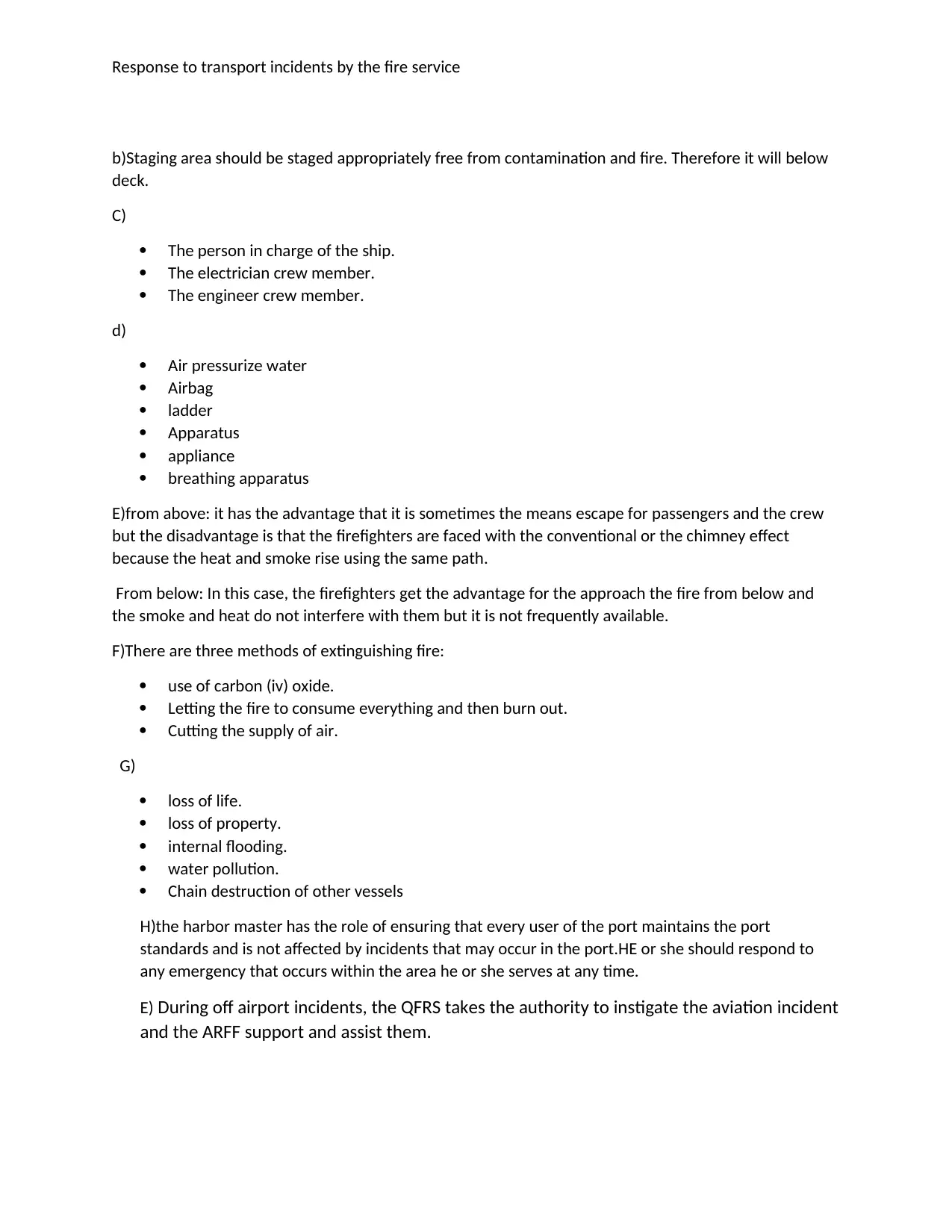
Response to transport incidents by the fire service
b)Staging area should be staged appropriately free from contamination and fire. Therefore it will below
deck.
C)
The person in charge of the ship.
The electrician crew member.
The engineer crew member.
d)
Air pressurize water
Airbag
ladder
Apparatus
appliance
breathing apparatus
E)from above: it has the advantage that it is sometimes the means escape for passengers and the crew
but the disadvantage is that the firefighters are faced with the conventional or the chimney effect
because the heat and smoke rise using the same path.
From below: In this case, the firefighters get the advantage for the approach the fire from below and
the smoke and heat do not interfere with them but it is not frequently available.
F)There are three methods of extinguishing fire:
use of carbon (iv) oxide.
Letting the fire to consume everything and then burn out.
Cutting the supply of air.
G)
loss of life.
loss of property.
internal flooding.
water pollution.
Chain destruction of other vessels
H)the harbor master has the role of ensuring that every user of the port maintains the port
standards and is not affected by incidents that may occur in the port.HE or she should respond to
any emergency that occurs within the area he or she serves at any time.
E) During off airport incidents, the QFRS takes the authority to instigate the aviation incident
and the ARFF support and assist them.
b)Staging area should be staged appropriately free from contamination and fire. Therefore it will below
deck.
C)
The person in charge of the ship.
The electrician crew member.
The engineer crew member.
d)
Air pressurize water
Airbag
ladder
Apparatus
appliance
breathing apparatus
E)from above: it has the advantage that it is sometimes the means escape for passengers and the crew
but the disadvantage is that the firefighters are faced with the conventional or the chimney effect
because the heat and smoke rise using the same path.
From below: In this case, the firefighters get the advantage for the approach the fire from below and
the smoke and heat do not interfere with them but it is not frequently available.
F)There are three methods of extinguishing fire:
use of carbon (iv) oxide.
Letting the fire to consume everything and then burn out.
Cutting the supply of air.
G)
loss of life.
loss of property.
internal flooding.
water pollution.
Chain destruction of other vessels
H)the harbor master has the role of ensuring that every user of the port maintains the port
standards and is not affected by incidents that may occur in the port.HE or she should respond to
any emergency that occurs within the area he or she serves at any time.
E) During off airport incidents, the QFRS takes the authority to instigate the aviation incident
and the ARFF support and assist them.
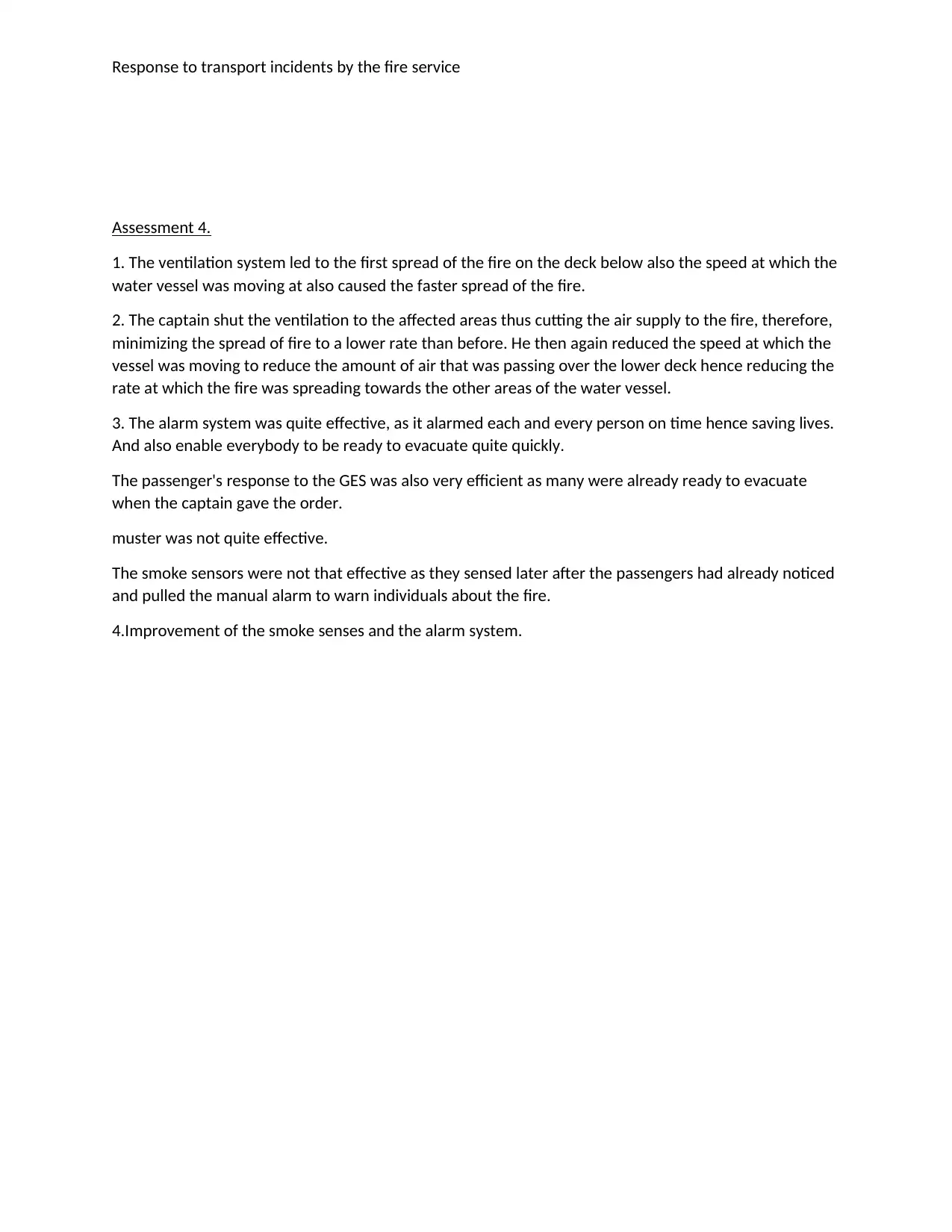
Response to transport incidents by the fire service
Assessment 4.
1. The ventilation system led to the first spread of the fire on the deck below also the speed at which the
water vessel was moving at also caused the faster spread of the fire.
2. The captain shut the ventilation to the affected areas thus cutting the air supply to the fire, therefore,
minimizing the spread of fire to a lower rate than before. He then again reduced the speed at which the
vessel was moving to reduce the amount of air that was passing over the lower deck hence reducing the
rate at which the fire was spreading towards the other areas of the water vessel.
3. The alarm system was quite effective, as it alarmed each and every person on time hence saving lives.
And also enable everybody to be ready to evacuate quite quickly.
The passenger's response to the GES was also very efficient as many were already ready to evacuate
when the captain gave the order.
muster was not quite effective.
The smoke sensors were not that effective as they sensed later after the passengers had already noticed
and pulled the manual alarm to warn individuals about the fire.
4.Improvement of the smoke senses and the alarm system.
Assessment 4.
1. The ventilation system led to the first spread of the fire on the deck below also the speed at which the
water vessel was moving at also caused the faster spread of the fire.
2. The captain shut the ventilation to the affected areas thus cutting the air supply to the fire, therefore,
minimizing the spread of fire to a lower rate than before. He then again reduced the speed at which the
vessel was moving to reduce the amount of air that was passing over the lower deck hence reducing the
rate at which the fire was spreading towards the other areas of the water vessel.
3. The alarm system was quite effective, as it alarmed each and every person on time hence saving lives.
And also enable everybody to be ready to evacuate quite quickly.
The passenger's response to the GES was also very efficient as many were already ready to evacuate
when the captain gave the order.
muster was not quite effective.
The smoke sensors were not that effective as they sensed later after the passengers had already noticed
and pulled the manual alarm to warn individuals about the fire.
4.Improvement of the smoke senses and the alarm system.
⊘ This is a preview!⊘
Do you want full access?
Subscribe today to unlock all pages.

Trusted by 1+ million students worldwide
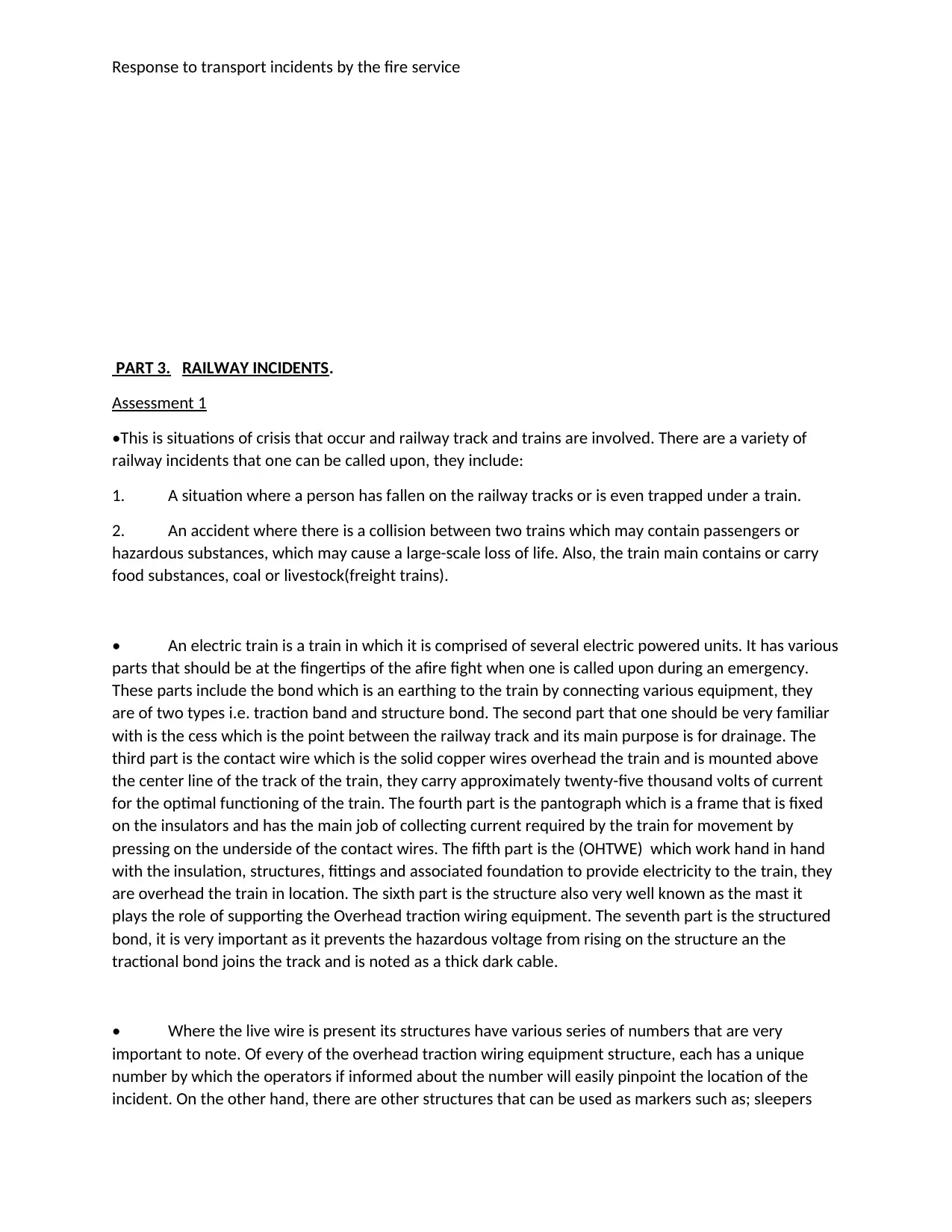
Response to transport incidents by the fire service
PART 3. RAILWAY INCIDENTS.
Assessment 1
•This is situations of crisis that occur and railway track and trains are involved. There are a variety of
railway incidents that one can be called upon, they include:
1. A situation where a person has fallen on the railway tracks or is even trapped under a train.
2. An accident where there is a collision between two trains which may contain passengers or
hazardous substances, which may cause a large-scale loss of life. Also, the train main contains or carry
food substances, coal or livestock(freight trains).
• An electric train is a train in which it is comprised of several electric powered units. It has various
parts that should be at the fingertips of the afire fight when one is called upon during an emergency.
These parts include the bond which is an earthing to the train by connecting various equipment, they
are of two types i.e. traction band and structure bond. The second part that one should be very familiar
with is the cess which is the point between the railway track and its main purpose is for drainage. The
third part is the contact wire which is the solid copper wires overhead the train and is mounted above
the center line of the track of the train, they carry approximately twenty-five thousand volts of current
for the optimal functioning of the train. The fourth part is the pantograph which is a frame that is fixed
on the insulators and has the main job of collecting current required by the train for movement by
pressing on the underside of the contact wires. The fifth part is the (OHTWE) which work hand in hand
with the insulation, structures, fittings and associated foundation to provide electricity to the train, they
are overhead the train in location. The sixth part is the structure also very well known as the mast it
plays the role of supporting the Overhead traction wiring equipment. The seventh part is the structured
bond, it is very important as it prevents the hazardous voltage from rising on the structure an the
tractional bond joins the track and is noted as a thick dark cable.
• Where the live wire is present its structures have various series of numbers that are very
important to note. Of every of the overhead traction wiring equipment structure, each has a unique
number by which the operators if informed about the number will easily pinpoint the location of the
incident. On the other hand, there are other structures that can be used as markers such as; sleepers
PART 3. RAILWAY INCIDENTS.
Assessment 1
•This is situations of crisis that occur and railway track and trains are involved. There are a variety of
railway incidents that one can be called upon, they include:
1. A situation where a person has fallen on the railway tracks or is even trapped under a train.
2. An accident where there is a collision between two trains which may contain passengers or
hazardous substances, which may cause a large-scale loss of life. Also, the train main contains or carry
food substances, coal or livestock(freight trains).
• An electric train is a train in which it is comprised of several electric powered units. It has various
parts that should be at the fingertips of the afire fight when one is called upon during an emergency.
These parts include the bond which is an earthing to the train by connecting various equipment, they
are of two types i.e. traction band and structure bond. The second part that one should be very familiar
with is the cess which is the point between the railway track and its main purpose is for drainage. The
third part is the contact wire which is the solid copper wires overhead the train and is mounted above
the center line of the track of the train, they carry approximately twenty-five thousand volts of current
for the optimal functioning of the train. The fourth part is the pantograph which is a frame that is fixed
on the insulators and has the main job of collecting current required by the train for movement by
pressing on the underside of the contact wires. The fifth part is the (OHTWE) which work hand in hand
with the insulation, structures, fittings and associated foundation to provide electricity to the train, they
are overhead the train in location. The sixth part is the structure also very well known as the mast it
plays the role of supporting the Overhead traction wiring equipment. The seventh part is the structured
bond, it is very important as it prevents the hazardous voltage from rising on the structure an the
tractional bond joins the track and is noted as a thick dark cable.
• Where the live wire is present its structures have various series of numbers that are very
important to note. Of every of the overhead traction wiring equipment structure, each has a unique
number by which the operators if informed about the number will easily pinpoint the location of the
incident. On the other hand, there are other structures that can be used as markers such as; sleepers
Paraphrase This Document
Need a fresh take? Get an instant paraphrase of this document with our AI Paraphraser
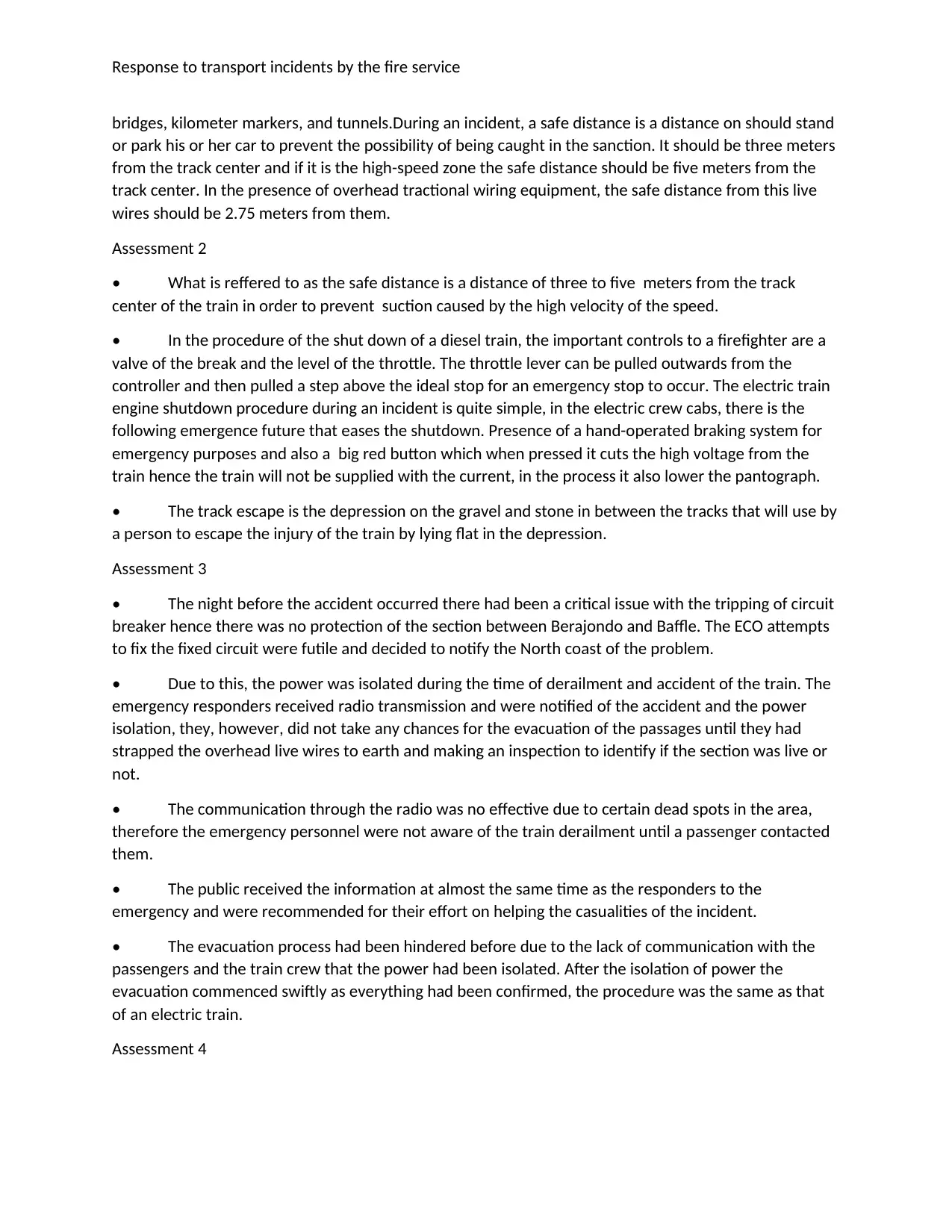
Response to transport incidents by the fire service
bridges, kilometer markers, and tunnels.During an incident, a safe distance is a distance on should stand
or park his or her car to prevent the possibility of being caught in the sanction. It should be three meters
from the track center and if it is the high-speed zone the safe distance should be five meters from the
track center. In the presence of overhead tractional wiring equipment, the safe distance from this live
wires should be 2.75 meters from them.
Assessment 2
• What is reffered to as the safe distance is a distance of three to five meters from the track
center of the train in order to prevent suction caused by the high velocity of the speed.
• In the procedure of the shut down of a diesel train, the important controls to a firefighter are a
valve of the break and the level of the throttle. The throttle lever can be pulled outwards from the
controller and then pulled a step above the ideal stop for an emergency stop to occur. The electric train
engine shutdown procedure during an incident is quite simple, in the electric crew cabs, there is the
following emergence future that eases the shutdown. Presence of a hand-operated braking system for
emergency purposes and also a big red button which when pressed it cuts the high voltage from the
train hence the train will not be supplied with the current, in the process it also lower the pantograph.
• The track escape is the depression on the gravel and stone in between the tracks that will use by
a person to escape the injury of the train by lying flat in the depression.
Assessment 3
• The night before the accident occurred there had been a critical issue with the tripping of circuit
breaker hence there was no protection of the section between Berajondo and Baffle. The ECO attempts
to fix the fixed circuit were futile and decided to notify the North coast of the problem.
• Due to this, the power was isolated during the time of derailment and accident of the train. The
emergency responders received radio transmission and were notified of the accident and the power
isolation, they, however, did not take any chances for the evacuation of the passages until they had
strapped the overhead live wires to earth and making an inspection to identify if the section was live or
not.
• The communication through the radio was no effective due to certain dead spots in the area,
therefore the emergency personnel were not aware of the train derailment until a passenger contacted
them.
• The public received the information at almost the same time as the responders to the
emergency and were recommended for their effort on helping the casualities of the incident.
• The evacuation process had been hindered before due to the lack of communication with the
passengers and the train crew that the power had been isolated. After the isolation of power the
evacuation commenced swiftly as everything had been confirmed, the procedure was the same as that
of an electric train.
Assessment 4
bridges, kilometer markers, and tunnels.During an incident, a safe distance is a distance on should stand
or park his or her car to prevent the possibility of being caught in the sanction. It should be three meters
from the track center and if it is the high-speed zone the safe distance should be five meters from the
track center. In the presence of overhead tractional wiring equipment, the safe distance from this live
wires should be 2.75 meters from them.
Assessment 2
• What is reffered to as the safe distance is a distance of three to five meters from the track
center of the train in order to prevent suction caused by the high velocity of the speed.
• In the procedure of the shut down of a diesel train, the important controls to a firefighter are a
valve of the break and the level of the throttle. The throttle lever can be pulled outwards from the
controller and then pulled a step above the ideal stop for an emergency stop to occur. The electric train
engine shutdown procedure during an incident is quite simple, in the electric crew cabs, there is the
following emergence future that eases the shutdown. Presence of a hand-operated braking system for
emergency purposes and also a big red button which when pressed it cuts the high voltage from the
train hence the train will not be supplied with the current, in the process it also lower the pantograph.
• The track escape is the depression on the gravel and stone in between the tracks that will use by
a person to escape the injury of the train by lying flat in the depression.
Assessment 3
• The night before the accident occurred there had been a critical issue with the tripping of circuit
breaker hence there was no protection of the section between Berajondo and Baffle. The ECO attempts
to fix the fixed circuit were futile and decided to notify the North coast of the problem.
• Due to this, the power was isolated during the time of derailment and accident of the train. The
emergency responders received radio transmission and were notified of the accident and the power
isolation, they, however, did not take any chances for the evacuation of the passages until they had
strapped the overhead live wires to earth and making an inspection to identify if the section was live or
not.
• The communication through the radio was no effective due to certain dead spots in the area,
therefore the emergency personnel were not aware of the train derailment until a passenger contacted
them.
• The public received the information at almost the same time as the responders to the
emergency and were recommended for their effort on helping the casualities of the incident.
• The evacuation process had been hindered before due to the lack of communication with the
passengers and the train crew that the power had been isolated. After the isolation of power the
evacuation commenced swiftly as everything had been confirmed, the procedure was the same as that
of an electric train.
Assessment 4
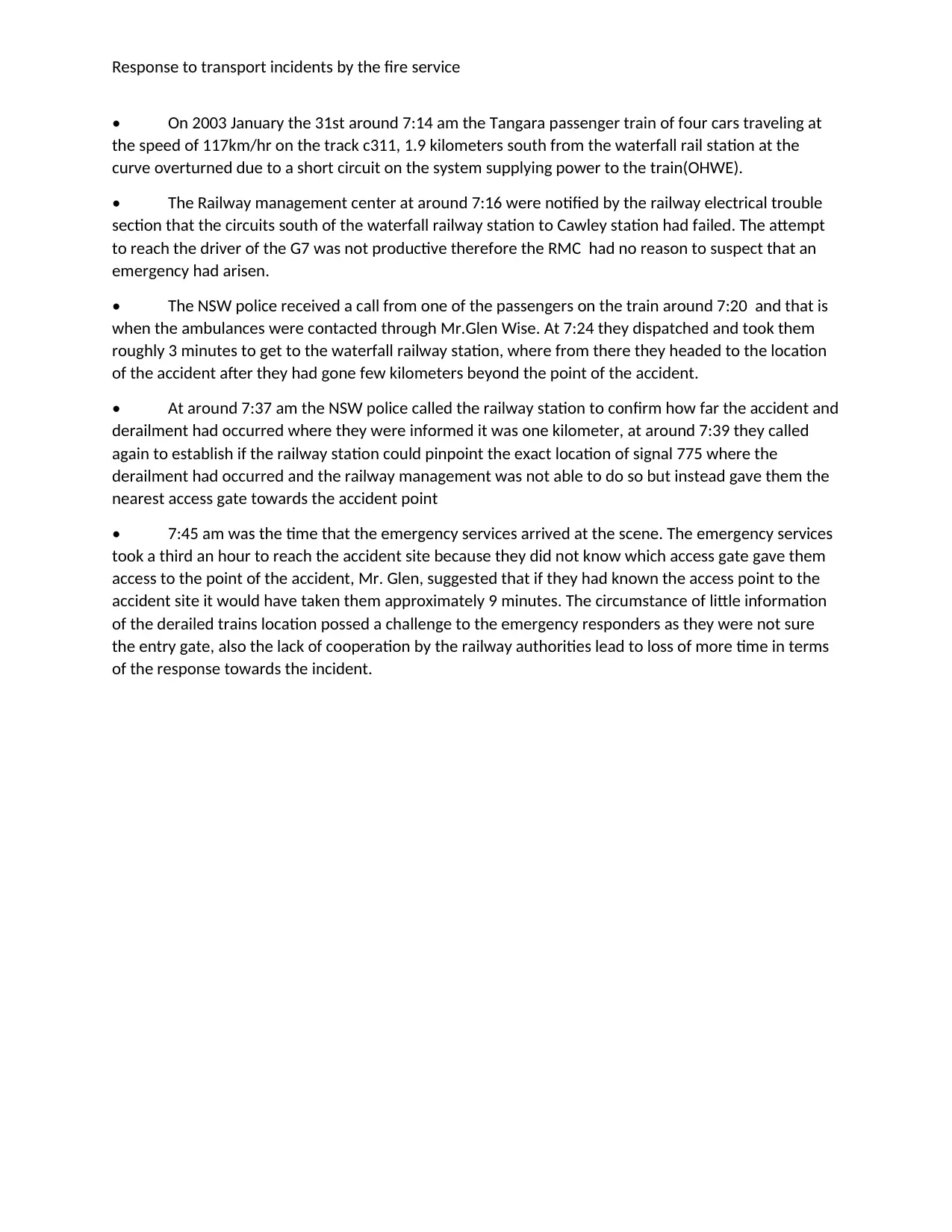
Response to transport incidents by the fire service
• On 2003 January the 31st around 7:14 am the Tangara passenger train of four cars traveling at
the speed of 117km/hr on the track c311, 1.9 kilometers south from the waterfall rail station at the
curve overturned due to a short circuit on the system supplying power to the train(OHWE).
• The Railway management center at around 7:16 were notified by the railway electrical trouble
section that the circuits south of the waterfall railway station to Cawley station had failed. The attempt
to reach the driver of the G7 was not productive therefore the RMC had no reason to suspect that an
emergency had arisen.
• The NSW police received a call from one of the passengers on the train around 7:20 and that is
when the ambulances were contacted through Mr.Glen Wise. At 7:24 they dispatched and took them
roughly 3 minutes to get to the waterfall railway station, where from there they headed to the location
of the accident after they had gone few kilometers beyond the point of the accident.
• At around 7:37 am the NSW police called the railway station to confirm how far the accident and
derailment had occurred where they were informed it was one kilometer, at around 7:39 they called
again to establish if the railway station could pinpoint the exact location of signal 775 where the
derailment had occurred and the railway management was not able to do so but instead gave them the
nearest access gate towards the accident point
• 7:45 am was the time that the emergency services arrived at the scene. The emergency services
took a third an hour to reach the accident site because they did not know which access gate gave them
access to the point of the accident, Mr. Glen, suggested that if they had known the access point to the
accident site it would have taken them approximately 9 minutes. The circumstance of little information
of the derailed trains location possed a challenge to the emergency responders as they were not sure
the entry gate, also the lack of cooperation by the railway authorities lead to loss of more time in terms
of the response towards the incident.
• On 2003 January the 31st around 7:14 am the Tangara passenger train of four cars traveling at
the speed of 117km/hr on the track c311, 1.9 kilometers south from the waterfall rail station at the
curve overturned due to a short circuit on the system supplying power to the train(OHWE).
• The Railway management center at around 7:16 were notified by the railway electrical trouble
section that the circuits south of the waterfall railway station to Cawley station had failed. The attempt
to reach the driver of the G7 was not productive therefore the RMC had no reason to suspect that an
emergency had arisen.
• The NSW police received a call from one of the passengers on the train around 7:20 and that is
when the ambulances were contacted through Mr.Glen Wise. At 7:24 they dispatched and took them
roughly 3 minutes to get to the waterfall railway station, where from there they headed to the location
of the accident after they had gone few kilometers beyond the point of the accident.
• At around 7:37 am the NSW police called the railway station to confirm how far the accident and
derailment had occurred where they were informed it was one kilometer, at around 7:39 they called
again to establish if the railway station could pinpoint the exact location of signal 775 where the
derailment had occurred and the railway management was not able to do so but instead gave them the
nearest access gate towards the accident point
• 7:45 am was the time that the emergency services arrived at the scene. The emergency services
took a third an hour to reach the accident site because they did not know which access gate gave them
access to the point of the accident, Mr. Glen, suggested that if they had known the access point to the
accident site it would have taken them approximately 9 minutes. The circumstance of little information
of the derailed trains location possed a challenge to the emergency responders as they were not sure
the entry gate, also the lack of cooperation by the railway authorities lead to loss of more time in terms
of the response towards the incident.
⊘ This is a preview!⊘
Do you want full access?
Subscribe today to unlock all pages.

Trusted by 1+ million students worldwide
1 out of 15
Related Documents
Your All-in-One AI-Powered Toolkit for Academic Success.
+13062052269
info@desklib.com
Available 24*7 on WhatsApp / Email
![[object Object]](/_next/static/media/star-bottom.7253800d.svg)
Unlock your academic potential
Copyright © 2020–2025 A2Z Services. All Rights Reserved. Developed and managed by ZUCOL.





